Search engine optimization (SEO) content writing is about creating strategic pieces of content that rank at the top of search engine results pages. Why? To get the right people to visit websites, interact with brands, and eventually convert.
When there’s no SEO pro behind content, the pages will likely get lost in the vast sea of websites, never to be found on search engines by potential customers. So, good SEO content writers are very valuable to anyone who wants to be found online.
Here’s a closer look at everything you need to know about SEO writing, including 14 best practices (with real examples).
Note: We’ve included affiliate links to some of the products and services we recommend.
What is an SEO content writer?

An SEO content writer writes educational pieces of digital marketing content. They aim to reach target audiences searching for specific terms and provide them with satisfying answers to their questions.
Here’s how it breaks down:
- SEO is an acronym that stands for Search Engine Optimization. It involves understanding the ranking factors that search engines use when formulating the search results pages.
- Content writing refers to a type of writing used in digital marketing campaigns to educate the target audience and build rapport. It often takes the form of blog posts, articles, guides, and social media posts.
SEO content writers certainly aim to write content that reaches the first page of the search results. However, the whole point of ranking is to reach people and answer their questions. So, if you’re an SEO content writer, your content needs to be as helpful as possible to your human readers, while also ticking the boxes for the bots.
Pro tip: Don’t sacrifice the reader experience for the bot experience. For example, you don’t want to overuse keywords to the point where they are repetitive and awkward (aka keyword stuffing).
SEO content writing vs. SEO copywriting
Is there a difference between SEO copywriting and SEO content writing? Indeed, there is! This chart breaks down the key differences:
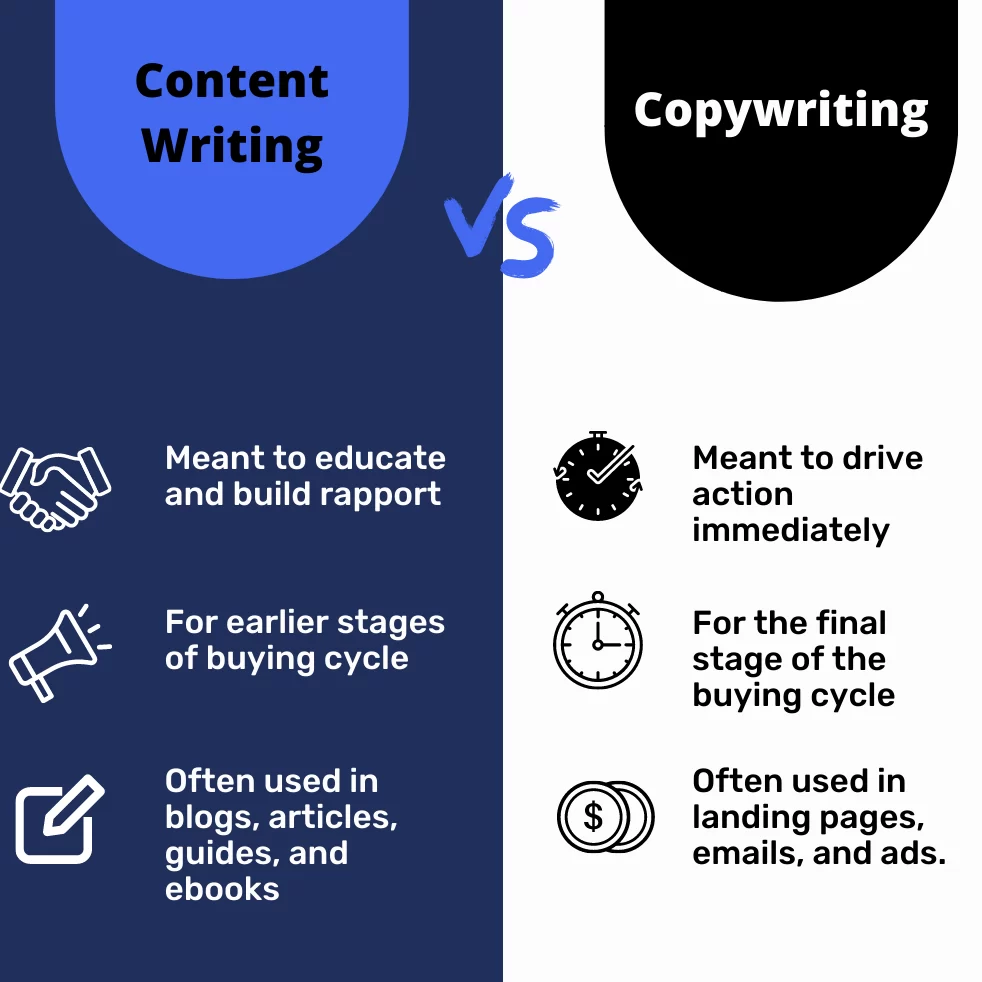
If someone was trying to ask you on a date, the content writer would strike up a friendly conversation, find some common ground, and let you know where you could find them. The copywriter would ask you right then and there using a persuasive and direct approach.
Both types of writing have their place in a marketing campaign and require the adoption of a brand’s voice. Further, both should be optimized for SEO if they are going to be published on public web properties (that the owners want people to find through search engines).
Many writers specialize in either copy or content writing. If you’re a writer, each will require different skills you’ll have to fine-tune. If you’re hiring a writer, ensure you find one with proven experience in the type of writing you need; SEO copy or content.
SEO strategy comes before SEO content writing

How do you get started with SEO content writing? An SEO content writer can’t do their job until the proper research has been done by an SEO strategist.
A strategist seeks to understand a business’s goals, competition, and market. Then, they perform keyword research to find answers to the following questions:
- High search volume: What words and phrases do people search for when on the path to buying the business’s solutions?
- Low competition: Which relevant highly-searched words and phrases have low competition?
- Relevance: Which words with high search volume and low competition can be made into relevant, helpful content for the target audience?
Once strategic keywords are identified, a detailed content brief should be created for each keyword.
Tip: Some SEO content writers offer SEO content strategies while others don’t. It requires an additional skill set. As a writer, you can greatly up your earnings by becoming an expert on the strategy side. SEO reporting tools like SEMrush can help you to get your feet wet. As a business owner, you need to know if your SEO content writer provides the strategy or if you need to get it from someone else.
14 SEO content writing best practices (with examples)
Now, how do you write effective SEO content?
With a detailed brief ready, an experienced SEO content writer can work their magic. Here are some of the best practices to create a final piece that’s SEO-friendly.
1. Align with user intent
First and foremost, you need to think about why people search the keyword you are targeting. What answer are they looking for? When they land on your page, they need to immediately know they can find the answers they want. Plus, you should entice them to want to stay as long as possible (increase dwell time).
Tip: You can learn more about the user intent of a keyword by searching for it using a search engine like Google. The top results will reveal what the search engine “thinks” people are looking for.
For example, if I search “orange juice,” you can see below that Google “thinks” my intent might be that I want to buy orange juice, make orange juice, or know what orange juice is.
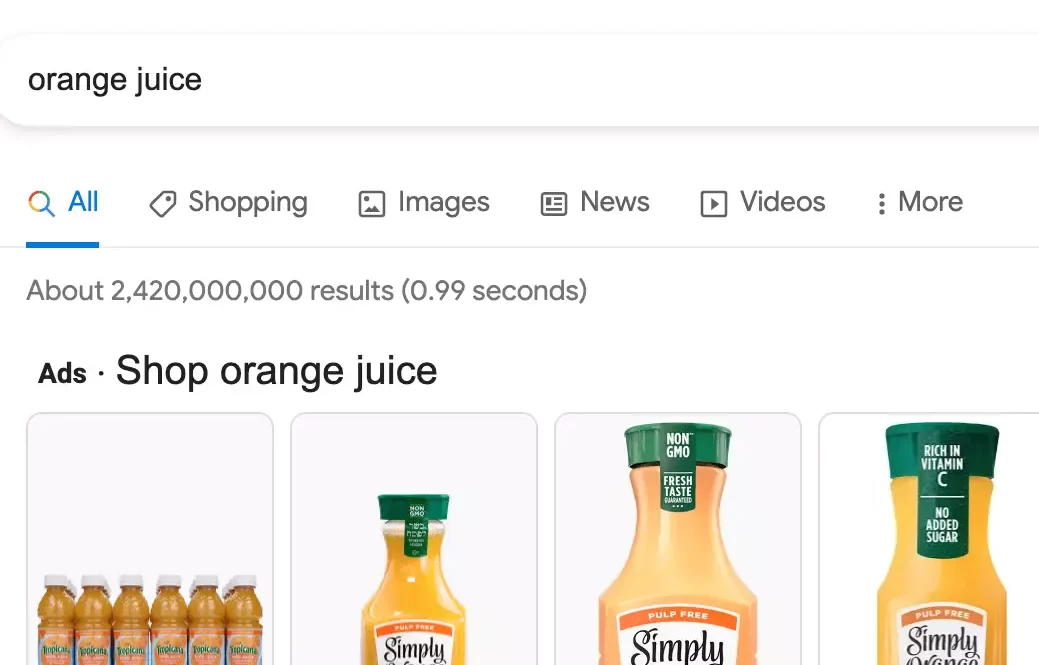
If I search “freelance writing,” the top results cover the basics of freelance writing including what it is, if it’s a good career, and how to find jobs.

“The “people also ask” section is also an invaluable tool for understanding related searches and how to leverage them,” said Emmanuel Njomo, Executive Director of Marketing at MedSchoolCoach.
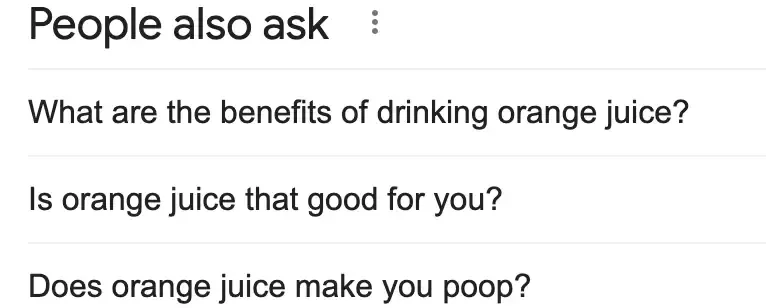
He adds, “The related searches don’t always make the most sense but then again it’s kind of the same way with people, so maybe it does. Similar to how the customer is always right (about what they want), the user’s search terms are always right — listen, react, empathize, entertain, then educate!”
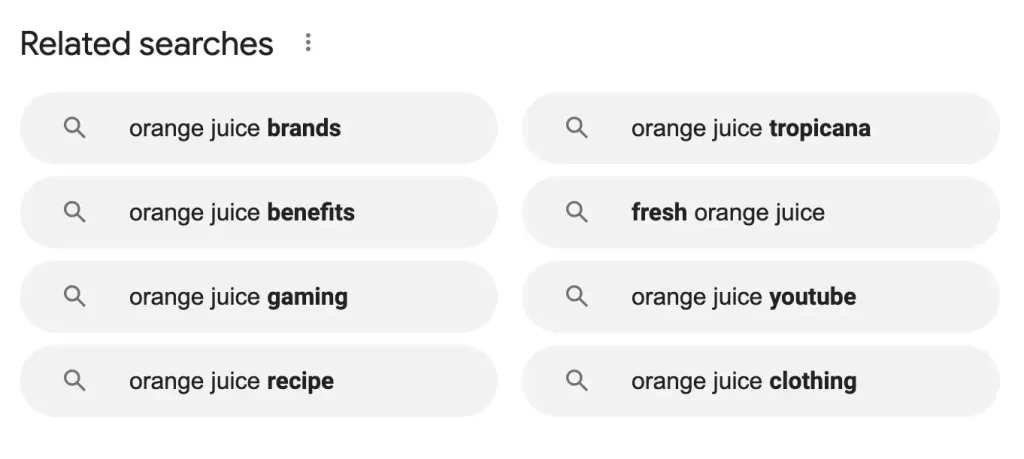
2. Title tag
The article title (also known as a title tag) should include the main keyword that the piece is targeting as early as possible. Keep in mind that only 50-60 characters will be visible in search engine results before it gets truncated. Then, the searchers will see “…”

Along with including the main keyword, the title needs to:
- Show the searcher that the article will answer their question (user intent is important once again).
- Give them a real reason to choose the article above the rest (no clickbait). This can take some practice as it’s more of a copywriting skill.
If you’re not sure where to start, perform a few searches and take notes on the characteristics of the titles in the top search results. Some of my observations from top-ranking titles include:
- Frequently asked questions work well as titles like “What is Blogging?” and “Why Should You Create a Blog?”
- How-to’s also top the list like, “How to Start a Successful Blog in 2022.” Also, note the inclusion of the year for relevance.
- Listicles that start with numbers can work well like, “17 Blogging Tips for Beginners.”
- Titles with specific results can also work well like Neil Patel’s, ” How to Start a Blog That Generates $3817 a Month
Tip: Spend a bit of time on the title as it sells the content. It determines whether people ultimately click or not and whether all the time spent writing was worth it. Brainstorm a few ideas and then pick “the one.”
3. Meta descriptions
In short, meta descriptions are the small pieces of text that display under the titles in the search engine results. As an SEO writer, they give you another chance to help the reader understand that your page offers the best answer to their question.
A few things to keep in mind are:
- Include the primary keyword.
- Your description will be truncated (and the ”…” will appear) at anywhere from 110ish to 155 characters. Make sure the beginning makes sense and packs a punch!
- We’re talking about character counts here, not word counts. (I’ve seen writers accidentally write out 150 words so just thought I’d throw that in there).
For an example, look at the meta description above. It begins to list the tips from the article, hinting at the value you’ll get if you click through.
Want more examples? Pay attention to the meta descriptions next time you Google somethin’!
4. URLs

The URL is the web address for the page being written. It will be the main website address with a slash and then what’s called the slug.
The slug should include your primary keyword. Also, it’s best practice to remove any words that aren’t absolutely necessary. Keep it short, easy to read, and easy to understand.
Note: URLs can’t include spaces so “-” symbols are used to break up the words.
If you have Yoast in WP, you can add the slug right below where you add the article or blog. Easy peasy.
“URLs may seem insignificant in comparison to other elements such as headers and on-page copy but they play a powerful role in SEO success. Using URLs accurately is crucial for search engines and people to understand your website,” said Jeff Collins, Freelance SEO Consultant.
5. Opening paragraph
Next, opening paragraph/introduction of the article needs to include the primary keyword. It helps to tell search engines and human readers that the page is actually about the keyword being searched.
Beyond that, the opening paragraph is key to getting readers to keep reading. It should:
- Acknowledge the audience’s problem or briefly answer their question.
- Touch on the pain points, and risks of not solving the problem.
- Tell them what value/benefit they’ll get if they keep reading.
You don’t want to go off on any tangents or drone on. Just keep it concise, clear, relevant, and enticing. Remember, the rest of the piece won’t matter if you don’t hook the reader in the intro!
Tip: Write the intro last, once you know everything the article or blog offers. It makes it easier to sell.
6. Headings
Web content should contain header tags to break up the text. Nobody’s eyes or brains like huge blocks of text. Plus, we often like to scan for the info we need.
Content management systems (like WordPress) and word processors (like Google docs) let you designate headers.
When you do, an HTML element is added which tells search engine bots that words are headings.
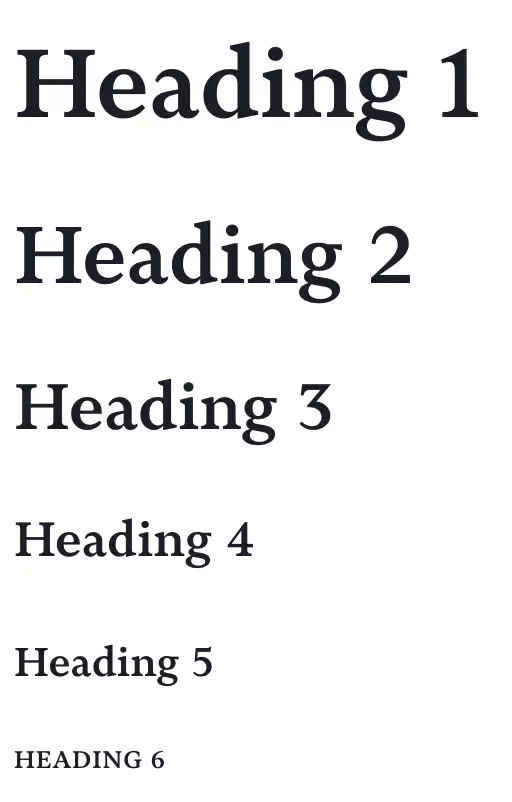
Warning: Simply bolding and enlarging text won’t have the same effect.
Headers typically range from H1 to H6…
- H1 is used for the title
- H2s are used for the main section headings
- Subsequent headings should be H3 through H6 (as needed)
Higher heading numbers mean higher importance.
For example, if this section was an article, some of the headers might go something like this:
H1 How to Use Headings In SEO Content
H2 Tips on Using Headings
H3 Use Keywords
H3 Limit Section Size
H3 Keep Them Short
Other heading tips:
- It’s good to include primary and secondary keywords in the headings.
- It’s best to limit sections between headers to no more than 300 words.
- Headings should be short, concise, and clear, helping bots and people navigate the piece more easily.
“One of the biggest errors on most sites is a misuse of headlines,” says Thomas J. Armitage, a Sales Executive at digital marketing agency Site-Seeker. He explains, “A page might start with an H1 then go to an H3, then to an H5, then back to an H1 (because people use headings for style rather than SEO). And that’s a bad move because Google looks to them to understand page/topic/info hierarchy. So when it’s a mess, Google won’t provide those keywords with the value they deserve.”
7. Keyword density

Keyword density refers to how often your keyword appears relative to the total word count of the page. Too high and your site will be penalized for keyword stuffing. Too low, and it may not rank well for the keyword. According to the Alexa blog, most SEO experts believe the ideal density is between 1% and 2%.
That said, use your discretion to create the best user experience. The primary and secondary keyword phrases you’re targeting should be used to create the article or blog post outline. Being so, their use should be pretty natural as you write and they should be distributed throughout the article fairly evenly.
You can also use tools like SEO Surfer to find a bunch of other keywords being used in content that’s ranking for your main keyword (along with the recommended density for each). This is called Latent Semantic Indexing Keywords in Content (LSI).
8. Links
Including both internal and external links within your content can help you rank better.
Internal links: Look for opportunities to add hyperlinks to phrases that will link to other helpful pages within your own website.
External links: Look for opportunities to add a few outbound links to other websites that are respected and trustworthy sources of information.
For example, if I was to hypothetically write a piece about SEO content writing and I have another article about meta descriptions, I could link to the meta descriptions piece so readers could learn more about that topic if they want.
I might also link to an authority on the matter (like Google) and a page where the company offers advice for publishers.
You don’t want so many links that it’s distracting or overwhelming.
But one every couple hundred words or so is good (where it makes sense and helps the reader).
Tip: Make sure the link works after you add it.
Another tip: The anchor text should tell what the link is about within a few words that flow naturally with the piece.
Why add internal links?
- They help Google understand your site better and give a page more context.
- They keep visitors on your site longer and give them more context.
Why add external links?
- Linking to trustworthy external websites can help search engines figure out what your site is about.
- It can also help you to appear to be more of an authority to search engines.
- And it can help your readers learn more and associate you with that trusted source.
So don’t forget, part of an optimized piece of content is making sure you have the right links!
9. Images
SEO content writing tip #9 has nothing to do with writing.
What?
Yep, it’s not about the words…
It’s about the images that break up the words.
And actually not just images.
It could be graphs, infographics, videos, sketch notes, etc.
Your content needs visual elements to break up the text, help tell the story, and appease the search engines.
You can make them, buy them, or find free stock photos (be sure to check the attribution and use requirements).
Other tips:
- You can find free and affordable photos on Unsplash, Pixabay, and Canva (I use Canva Pro for $12.99 per month).
- Convert image files into WEBP format and compress them before uploading.
- Add them throughout the piece in a stylistic way to enhance the reader experience. Not too much, not too little. I like to add one every couple hundred words so you’re never scrolling long without seeing a visual element.
Your images can rank on Google, too — helping to drive more traffic to your page. For example, an infographic or sketch note can be great magnets.
10. Image titles and alt text

When you upload the images, the title and alt text matter. Be sure to use a descriptive name for the title, and explain the purpose of the image for the alt text. Include keywords when it makes sense to do so.
Note, the alt text conveys the “why” of the image so that if the image fails or someone is using a screen reader, they can understand why it’s there.
11. Categories and tags
Organizing articles and blog posts into categories and using tags helps human and bot users to better understand and navigate the site. For example, we have blogs about business insights, finding clients, and more on All Things Freelance Writing.
12. Originality
The writing should be original and not found on any other website that a search engine crawls (sometimes it happens by accident). You can use tools like Copyscape to check for duplicate content.
13. Recency

The “last updated” date is also a factor, so it’s a good idea for SEO content writers to regularly review and update content to ensure it’s relevant and up to date (at least annually).
It also helps to post blogs on a regular schedule as it encourages people to keep returning. However, don’t sacrifice quality for frequency or you could shoot yourself in the foot.
14. Focus on a great overall user experience

Overall, a great SEO content writer is tuned into the needs of the people they want to reach. They write in an effort to engage and satisfy the traffic that arrives.
What you don’t want are people arriving and immediately clicking back to find a better answer. Search engines also track the behavior of users once they are on a site. So along with all of the above, SEO content writers should ask, “If I was asking the question, would I think this is the best, most complete and useful answer to the question?”
Frequently asked questions about SEO content writing

Now, here are answers to frequently asked questions about SEO content writing.
Who needs an SEO content writer?
Any person or business that wants people coming to their website for one reason or another will benefit from content that ranks for the right terms. That includes small business owners, e-commerce stores, non-profits, corporations, bloggers, news sites, and more. SEO and content distribution are the two main keys to content marketing.
How do I become an SEO content writer?
To become an SEO content writer, you will need to:
- Learn the basics of content writing and content marketing. You can do so by researching top-ranking content from authority sites, reading online guides, hiring a coach or mentor, taking a course, listening to helpful podcast episodes about writing, etc.
- Learn SEO for blogs and articles. Google provides some great resources. We covered the basics above.
- Write some samples (can self-publish on Medium, LinkedIn, your website, etc.).
- Consider picking a niche.
- Get to work and build a portfolio.
- Find freelance writing jobs.
Tip: One of the best ways to gain experience and confidence is to start your own website and experiment (it can be very basic/inexpensive).
Where can you see SEO content writing samples?
Finding samples of effective SEO content writing is very easy. Why? You can search literally anything using a search engine and look at the top results that pop up. Every time you read a top search result, you’re seeing an example of effective SEO content writing. Browse around and take notes.
Where can you find SEO content writing jobs?
You can find freelance writing jobs in many places online such as freelance writing job boards (<<check ours), Upwork, LinkedIn, Indeed, Facebook groups, Instagram, and various other platforms. You can also target businesses that publish content online and send them pitches.
Note that the average salary for an SEO content writer is around $63,000, according to Glassdoor. However, as an experienced freelancer, you have the potential to make much more, especially if you offer SEO content strategy, too.
Is content writing necessary for SEO?
Yes, you need content writing for SEO. Search engines crawl written words to understand what websites offer. The more pages, posts, and words your site has, the more opportunities you have to rank for different queries.
Final words on SEO content writing
Showing up to the right people who are searching for the right words takes some marketing know-how. Between an SEO strategist and an SEO content writer, it’s very possible. And with experts who know what they’re doing, the path to organic traffic, leads, and conversions will be much more direct.


[…] their use goes far beyond that. Read on to learn more about header tags, why they are important for SEO content writing, and how they help both human and bot website […]